Healthy Cooking
10 Easy and Healthy Weeknight Dinner Recipes That Will Transform Evenings
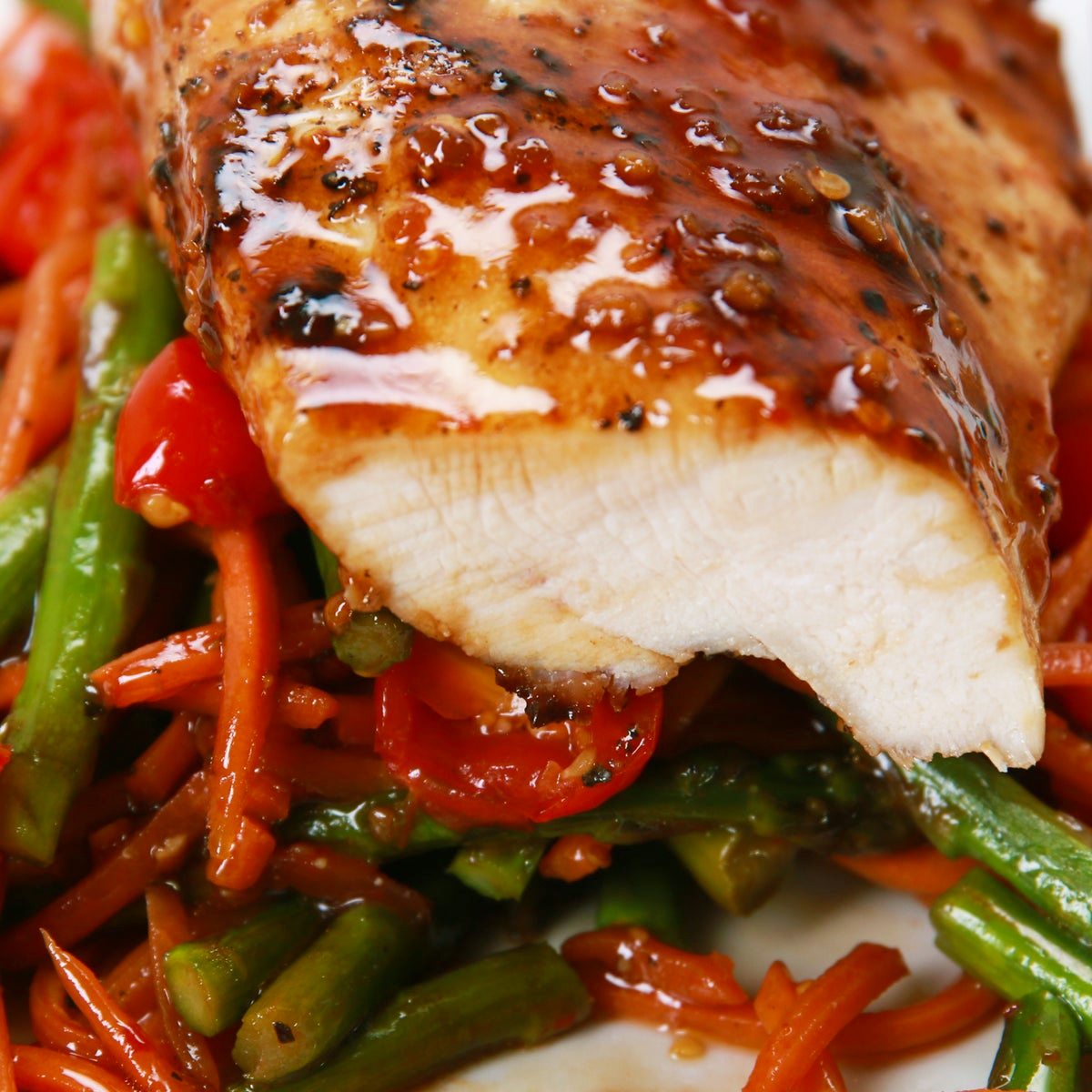
Why You Need These 10 Easy and Healthy Weeknight Dinner Recipes
In today’s fast-paced world, finding the time to prepare quick healthy dinners can seem like an impossible task. However, with a bit of weeknight meal planning and the right recipes, you can whip up easy nutritious meals that your whole family will love. This is where our collection of 10 easy and healthy weeknight dinner recipes comes in.
Imagine coming home after a long day, knowing exactly what simple dinner recipe you’ll be making—no stress, no fuss. These recipes are designed to be both delicious and wholesome, ensuring that you never have to compromise on health for convenience. Whether you’re cooking for picky eaters or trying to stick to a balanced diet yourself, these healthy family dinners are sure to become staples in your household.
So why wait? Dive into our curated list and discover how effortless it can be to serve up mouth-watering meals that nourish both body and soul. Your journey towards healthier eating starts here!
Recipe 1: 15-Minute Lemon Garlic Shrimp Pasta
If you’re searching for a quick pasta recipe that doesn’t skimp on flavor, look no further than our 15-Minute Lemon Garlic Shrimp Pasta. This dish is the epitome of an easy seafood dinner, combining the zest of lemon with the rich aroma of garlic to create a symphony of taste that will leave your taste buds dancing.

To start, you’ll need fresh shrimp, which are not only delicious but also packed with protein and low in calories, making this a healthy shrimp recipe you can feel good about. Begin by sautéing minced garlic in olive oil until it’s golden and fragrant. Then, add your shrimp and cook until they turn pink and opaque—this should take just a few minutes.
Next, squeeze fresh lemon juice over the shrimp and add zest for an extra burst of citrus flavor. Toss in cooked pasta—spaghetti or linguine works best—and mix everything together until well-coated. For an added touch of elegance, sprinkle some chopped parsley and grated Parmesan cheese on top.
In just 15 minutes, you have a gourmet meal that’s perfect for busy weeknights or impressing guests without spending hours in the kitchen. With this lemon garlic shrimp pasta recipe in your repertoire, you’ll always have a go-to option for an easy seafood dinner that’s both healthy and extraordinarily tasty.
Recipe 2: One-Pan Balsamic Chicken and Veggies
If you’re on the hunt for a delicious, healthy chicken dinner that won’t leave you with a sink full of dishes, look no further than our One-Pan Balsamic Chicken and Veggies recipe. This balsamic chicken recipe is not only incredibly flavorful but also perfect for those busy weeknights when you need something quick and nutritious.
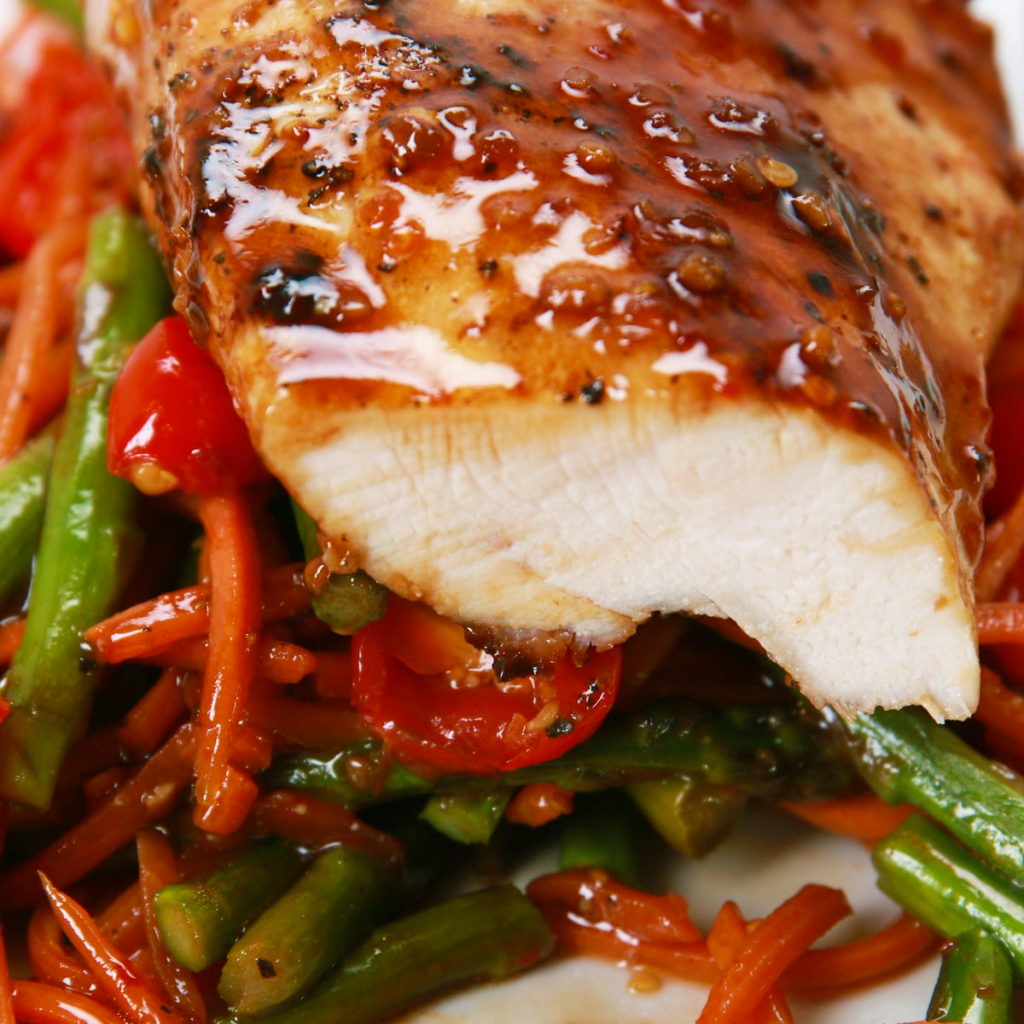
One-pan dinners are game-changers in the kitchen, simplifying both cooking and cleanup. The beauty of this dish lies in its simplicity—juicy chicken breasts are marinated in a tangy balsamic glaze and roasted alongside an array of colorful vegetables. Think tender carrots, crispy Brussels sprouts, and sweet bell peppers, all absorbing the rich flavors of balsamic vinegar.
This easy veggie recipe ensures you’re getting a balanced meal with minimal effort. Just toss everything together on a single baking sheet, pop it in the oven, and let it work its magic. In less than an hour, you’ll have a wholesome meal that looks as good as it tastes.
So why not give this One-Pan Balsamic Chicken and Veggies recipe a try? It’s bound to become your go-to for healthy chicken dinners that are both effortless and delectable.
Recipe 3: Quinoa and Black Bean Stuffed Peppers
If you’re on the hunt for a delicious, nutritious, and easy-to-make vegetarian dinner idea, look no further than our Quinoa and Black Bean Stuffed Peppers. This stuffed peppers recipe is not only bursting with flavor but also packed with high-protein goodness that will leave you satisfied and energized.
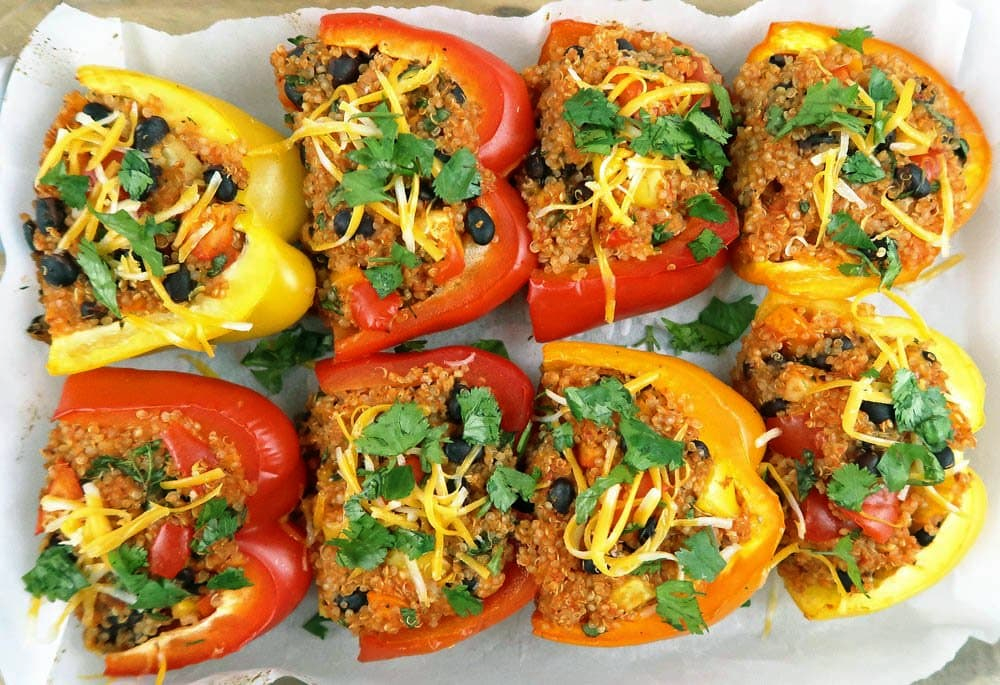
Quinoa, often hailed as a superfood, forms the hearty base of this dish. Rich in protein and fiber, quinoa is an excellent choice for those looking to maintain a balanced diet without sacrificing taste. Combined with black beans, another powerhouse of protein and essential nutrients, this recipe ensures that your meal is as nourishing as it is delectable.
To start off, cook your quinoa according to the package instructions until it’s light and fluffy. While the quinoa cooks, prepare your bell peppers by slicing off their tops and removing the seeds. Choose vibrant red or yellow peppers for a touch of sweetness that complements the savory filling perfectly.
In a large bowl, mix together the cooked quinoa, black beans (rinsed and drained), corn kernels for added texture, diced tomatoes for juiciness, chopped cilantro for freshness, and a blend of spices like cumin and smoked paprika to elevate the flavors. Spoon this delightful mixture into each hollowed-out pepper generously.
Bake these stuffed beauties in a preheated oven at 375°F (190°C) for about 30 minutes or until the peppers are tender yet firm enough to hold their shape. The result? A colorful array of Quinoa and Black Bean Stuffed Peppers that are sure to impress both vegetarians and non-vegetarians alike.
Not only does this dish make an excellent weeknight dinner option due to its simplicity and quick prep time but it also doubles as an impressive centerpiece for any gathering or potluck. So why wait? Give this high-protein meal a try tonight – your taste buds will thank you!
Recipe 4: Zucchini Noodles with Pesto and Cherry Tomatoes
If you’re on the hunt for a delicious, low-carb dinner idea that doesn’t skimp on flavor, look no further than our Zucchini Noodles with Pesto and Cherry Tomatoes. This vibrant dish is not only a feast for the eyes but also incredibly satisfying and perfect for vegan weeknight meals.
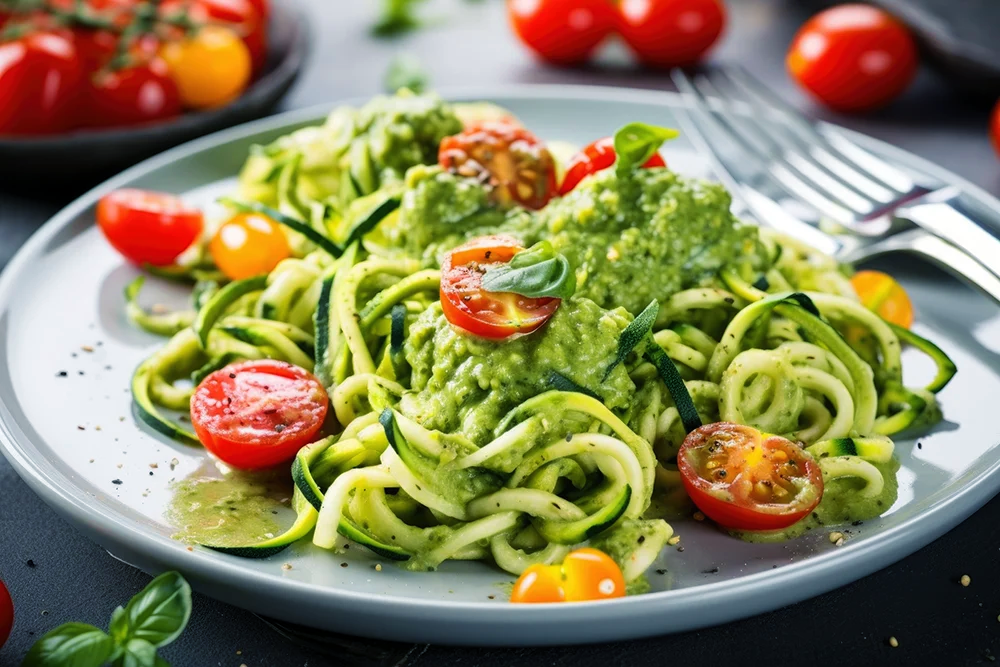
Zucchini noodles, often affectionately called “noodles,” offer a fantastic pasta alternative that’s both light and nutritious. They serve as the perfect base for this recipe, soaking up all the rich flavors of homemade pesto while keeping your meal low in carbs.
To start, spiralizer fresh zucchinis into noodle-like strands. These noodles mimic traditional pasta in texture but come with the added benefits of being gluten-free and packed with vitamins. Next, whip up a batch of creamy pesto using fresh basil leaves, pine nuts, garlic, olive oil, and nutritional yeast for that cheesy flavor without any dairy.
Toss your zucchini noodles in this vibrant green pesto until they’re well-coated. Then add juicy cherry tomatoes that burst with sweetness in every bite. The combination of these ingredients creates a harmonious blend that’s mouthwateringly good.
This zucchini noodles recipe is not just another vegan weeknight meal; it’s an experience that brings together simplicity and sophistication on one plate. Whether you’re looking to cut down on carbs or simply want to try something new and deliciously healthy, this dish will convince you that eating well doesn’t mean sacrificing taste.
Recipe 5: Honey Glazed Salmon with Asparagus
If you’re searching for a dinner recipe that combines simplicity, elegance, and incredible flavor, look no further than our Honey Glazed Salmon with Asparagus. This dish is a perfect example of how salmon recipes for dinner can be both quick and gourmet.
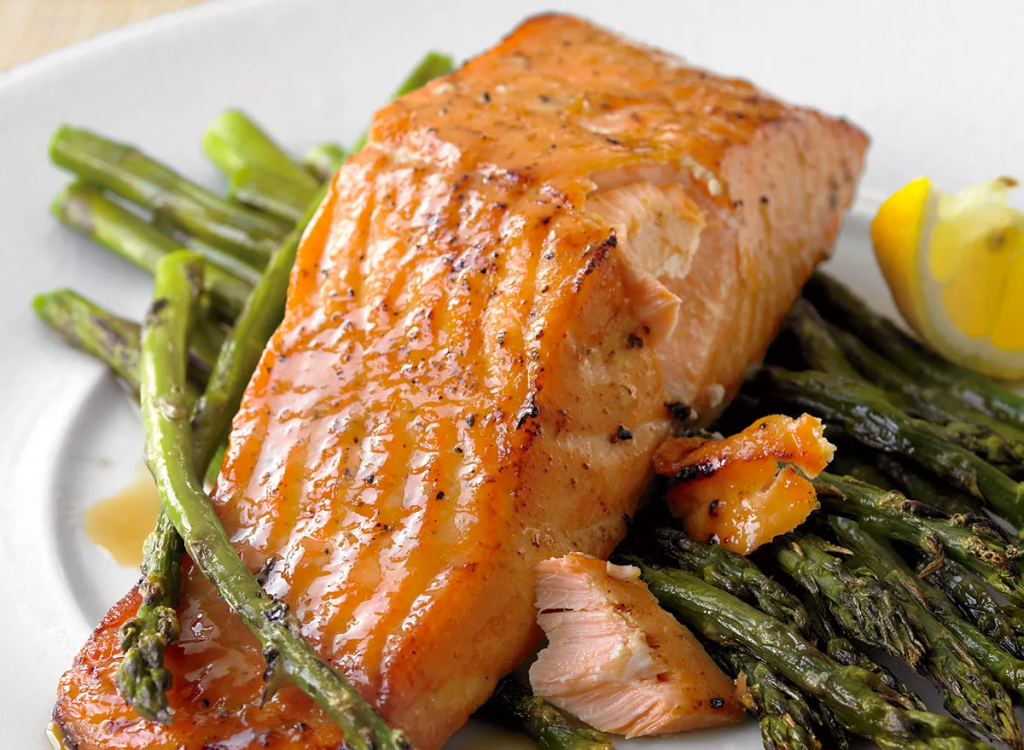
The honey glazed salmon recipe is straightforward yet delivers a burst of savory and sweet flavors that will leave your taste buds dancing. The glaze, made from honey, soy sauce, garlic, and a touch of lemon juice, caramelizes beautifully on the salmon fillets as they bake to perfection. This not only gives the fish an irresistible golden crust but also locks in moisture, ensuring every bite is succulent.
Pairing this delectable fish with asparagus elevates the meal to another level. Asparagus side dish ideas often revolve around simplicity to let the vegetable’s natural flavors shine through. Lightly seasoned with olive oil, salt, and pepper before roasting alongside the salmon allows the asparagus to become tender-crisp while absorbing some of that delicious glaze runoff.
This combination makes for a quick fish dish that’s ready in under 30 minutes but tastes like you spent hours preparing it. Whether you’re cooking for family or entertaining guests, Honey Glazed Salmon with Asparagus promises to impress without any fuss. Give it a try tonight and watch as this easy yet sophisticated meal becomes one of your go-to favorites!
Recipe 6: Chickpea and Spinach Curry in Under 30 Minutes
When it comes to whipping up a delicious, nutritious meal in no time, look no further than our Chickpea and Spinach Curry. This easy curry recipe is perfect for those busy weeknights when you need a hearty dinner on the table fast. Not only is it packed with flavor, but it’s also a fantastic vegetarian curry that even meat-lovers will adore.

To start, you’ll need some basic pantry staples: canned chickpeas, fresh spinach, coconut milk, and an array of fragrant spices. The beauty of this dish lies in its simplicity—yet it delivers complex flavors that are sure to impress. Begin by sautéing onions and garlic until they’re golden brown. Add in your spices like cumin, coriander, and turmeric to release their aromatic oils.
Next, toss in the chickpeas and coconut milk, letting them simmer together to create a rich sauce that’s both creamy and satisfying. Finally, stir in the fresh spinach just before serving; it wilts perfectly into the hot curry without losing its vibrant green color or nutritional punch.
This quick spinach dish not only saves you time but also ensures you’re feeding yourself and your loved ones with wholesome ingredients. Whether you’re new to plant-based dinners or a seasoned pro looking for something fresh and exciting, this Chickpea and Spinach Curry is bound to become a staple in your kitchen repertoire.
So why wait? Give this easy chickpea curry recipe a try tonight—you’ll be amazed at how effortlessly you can create such an incredible meal in under 30 minutes!
Recipe 7: Spaghetti Squash with Ground Turkey Marinara
If you’re on the hunt for a delicious low-carb Italian food option, look no further than Recipe 7: Spaghetti Squash with Ground Turkey Marinara. This dish is not only packed with flavor but also offers a healthy alternative to traditional pasta. Spaghetti squash serves as the perfect substitute, providing that familiar spaghetti texture without the carb overload.
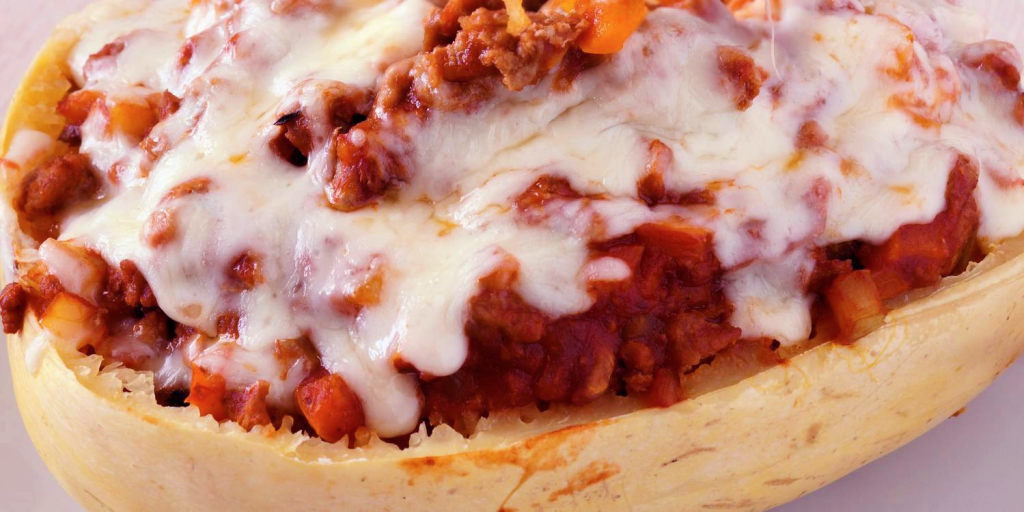
Ground turkey recipes are known for their versatility and health benefits, and this one is no exception. The ground turkey marinara sauce is rich and savory, complementing the subtle sweetness of the spaghetti squash perfectly. Plus, it’s incredibly easy to prepare!
To start, roast your spaghetti squash until it’s tender enough to shred into noodle-like strands. While that’s cooking, brown your ground turkey in a pan with some olive oil until fully cooked. Add in your favorite marinara sauce—whether homemade or store-bought—and let it simmer to absorb all those wonderful flavors.
Once everything is ready, simply toss the shredded spaghetti squash with the ground turkey marinara sauce. Garnish with fresh basil and a sprinkle of Parmesan cheese if you like. Not only will you enjoy a satisfying meal that feels indulgent, but you’ll also be making a smart choice for your health.
This recipe proves that healthy spaghetti alternatives can be just as comforting and delicious as their high-carb counterparts. Give it a try and see how easy it is to transform simple ingredients into an Italian feast that’s both nutritious and satisfying!
Recipe 8: Greek Chicken Gyro Bowls
Greek Chicken Gyro Bowls are a game-changer for anyone seeking a healthy, delicious, and easy-to-make meal that aligns with the Mediterranean diet. These gyro bowls are packed with flavorful marinated chicken, fresh vegetables, and a tangy tzatziki sauce that tantalizes your taste buds while providing a balanced mix of nutrients. Incorporating these bowls into your meal rotation is an effortless way to enjoy the benefits of the Mediterranean diet, known for its heart-healthy ingredients and emphasis on whole foods.
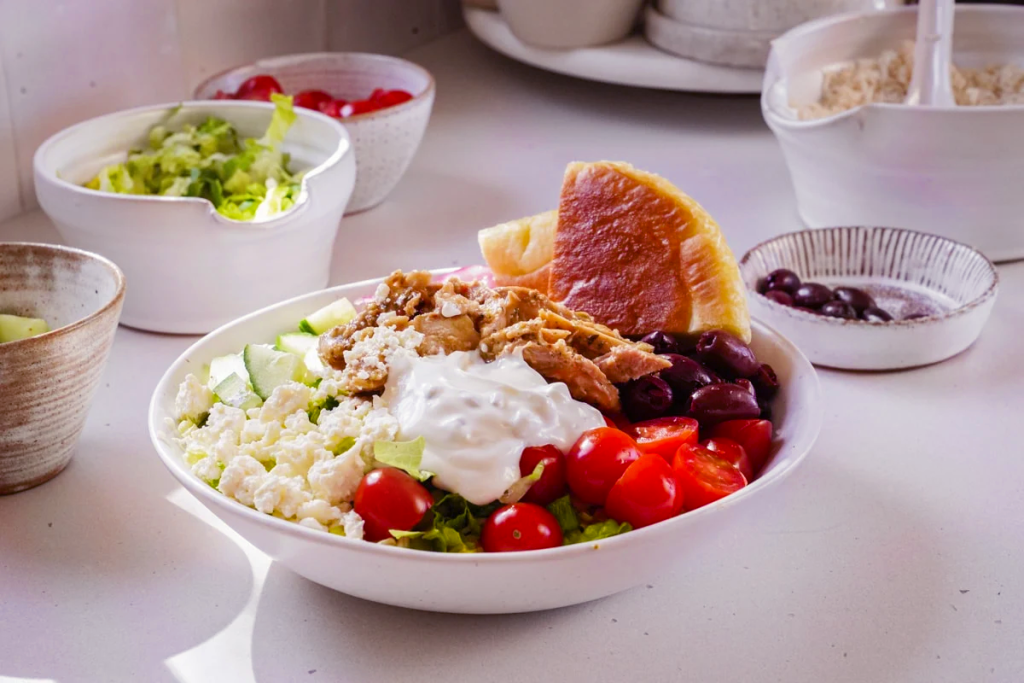
The simplicity of the recipe means you can prepare it quickly without sacrificing quality or flavor, making it perfect for busy weeknights or meal prep. Moreover, each bowl is customizable to suit your personal preferences or dietary needs, ensuring that everyone in your household can enjoy this wholesome dish. By choosing Greek Chicken Gyro Bowls, you’re opting for a nutritious and satisfying meal that supports your health goals while delivering an authentic taste of the Mediterranean right in your own kitchen.
In addition to their nutritional benefits, these Greek Chicken Gyro Bowls are a feast for the senses. The vibrant colors of the fresh vegetables create an appealing visual presentation, while the aromatic herbs and spices used in marinating the chicken infuse each bite with layers of complex flavors. The tangy tzatziki sauce not only adds a refreshing contrast but also ties all the components together into a harmonious dish.
What sets gyro bowls apart is their versatility. You can easily adjust ingredients based on what’s in season or what you have on hand, making this recipe both practical and adaptable. For those who prefer plant-based options, substituting grilled vegetables or chickpeas for the chicken still delivers an equally delicious and nutritious meal. Furthermore, these bowls are not just limited to dinner; they make an excellent choice for lunch as well. Packing them in containers makes them convenient for work or school meals that will keep you energized throughout your day.
By integrating Greek Chicken Gyro Bowls into your diet, you’re embracing a lifestyle that prioritizes health without compromising on taste or convenience. With every bowl you serve, you’ll be reminded of how effortless it can be to enjoy wholesome meals that nourish both body and soul. Don’t miss out on this opportunity to elevate your culinary repertoire with Recipe8’s Greek Chicken Gyro Bowls—your family will thank you!
Recipe 9: Cauliflower Fried Rice with Tofu
Are you looking for a delicious and healthy alternative to traditional fried rice? Look no further! Our Cauliflower Fried Rice with Tofu combines the nutty flavor of cauliflower rice with the savory goodness of tofu stir-fry. Not only is this dish low in calories, but it also packs a punch in terms of nutrition and taste.

Imagine enjoying all the flavors you love in Chinese food without any guilt. The cauliflower rice serves as an excellent base, offering a subtle crunch that perfectly complements the tender, marinated tofu pieces. Each bite bursts with vibrant vegetables, aromatic spices, and just the right amount of seasoning.
Plus, this recipe is incredibly easy to make and can be whipped up in under 30 minutes—ideal for those busy weeknights when you crave something quick yet satisfying. Whether you’re following a specific diet plan or simply want to incorporate more veggies into your meals, our Cauliflower Fried Rice with Tofu is the perfect choice. Try it today and discover how indulgent healthy eating can be!
Recipe 10: Sheet Pan Sausage and Root Vegetable Bake
Sheet Pan Sausage and Root Vegetable Bake is the ultimate solution for anyone seeking a hearty, hassle-free weeknight meal. This dish combines the robust flavors of savory sausage with the earthy sweetness of root vegetables, creating a balanced and satisfying dinner that requires minimal effort. With everything cooked on a single sheet pan, clean-up is a breeze, making it an ideal option for busy households.

The recipe calls for simple ingredients like carrots, potatoes, parsnips, and your favorite sausage links, all seasoned to perfection with herbs and spices that elevate the natural flavors. As it bakes in the oven, the vegetables caramelize beautifully while absorbing the rich juices from the sausage, resulting in a mouthwatering medley that’s both nutritious and delicious.
By offering an easy yet flavorful approach to dinner preparation, Sheet Pan Sausage and Root Vegetable Bake stands out as a must-try for anyone looking to simplify their cooking routine without compromising on taste or quality.
Conclusion: Why These Recipes Will Revolutionize Your Weeknights and How to Get Started Today
These recipes will revolutionize your weeknights by transforming mealtime from a stressful obligation into an enjoyable, effortless experience. With easy-to-follow instructions and readily available ingredients, they offer the perfect blend of convenience and culinary delight. Imagine coming home after a long day to a kitchen that promises quick, delicious meals without the hassle of extensive prep or cleanup.
These recipes not only save you time but also introduce variety and nutrition into your diet, ensuring that every meal is both satisfying and wholesome. To get started today, simply choose a recipe that appeals to you, gather your ingredients, and follow the straightforward steps provided. By incorporating these game-changing recipes into your routine, you’ll discover that weeknight dinners can be both simple and delightful, making every evening meal something to look forward to.

Healthy Cooking
10 Healthy Meals Prep Recipes for People Who Hate Salad
Eating healthy Meals doesn’t have to mean endless bowls of greens. This recipe collection is packed with flavor, variety, and creativity—perfect for anyone wanting to enjoy delicious, nutritious meals without a salad!
Description: A colorful filling bowl featuring quinoa, roasted rainbow veggies, and a zesty lemon-tahini dressing. This fiber-rich powerhouse is perfect for satisfying hunger while providing a balanced mix of protein, carbs, and healthy fats.
Key Ingredients: Quinoa, roasted bell peppers, zucchini, chickpeas, and tahini dressing.
Nutritional Information (Per Serving):
Calories: 400 | Protein: 15g | Carbs: 45g | Fat: 18g
Description: This vibrant stir-fry brings tofu, broccoli, and bell peppers in a flavorful ginger-soy sauce. Quick to make and perfect for a low-carb, protein-rich meal.
Key Ingredients: Firm tofu, broccoli, cauliflower rice, soy/ginger sauce.
Nutritional Information (Per Serving):
Calories: 350 | Protein: 20g | Carbs: 15g | Fat: 16g
Description: Mediterranean-style stuffed peppers brimming with lentils, quinoa, and feta, all baked in a rich tomato sauce. Gluten-free and protein-packed—the perfect warm and hearty meal.
Key Ingredients: Bell peppers, quinoa, lentils, feta cheese, tomato sauce.
Nutritional Information (Per Serving):
Calories: 400 | Protein: 18g | Carbs: 40g | Fat: 11g
Description: Spice up your routine with these tempeh tacos wrapped in crisp lettuce leaves and topped with fresh avocado and lime-cilantro slaw. A low-carb, guilt-free meal packed with bold flavors.
Key Ingredients: Tempeh, lettuce wraps, avocado, cabbage slaw, lime dressing.
Nutritional Information (Per Serving):
Calories: 320 | Protein: 16g | Carbs: 12g | Fat: 22g
Description: A light and refreshing low-carb pasta alternative made with zucchini noodles, fresh cherry tomatoes, and fragrant basil pesto, topped with pine nuts for added crunch.
Key Ingredients: Zucchini noodles, basil pesto, cherry tomatoes, pine nuts.
Nutritional Information (Per Serving):
Calories: 250 | Protein: 7g | Carbs: 10g | Fat: 21g
Description: Roasted spiced cauliflower served with a tangy harissa yogurt sauce and fresh Greek salad. This dish is a bold, flavorful nod to Mediterranean cuisine and is entirely gluten-free and low-carb.
Key Ingredients: Cauliflower, Greek yogurt, harissa, cucumber, cherry tomatoes.
Nutritional Information (Per Serving):
Calories: 300 | Protein: 10g | Carbs: 18g | Fat: 20g
Description: A hearty combination of roasted sweet potatoes, crispy chickpeas, and a creamy avocado-lime dressing. Perfectly balanced and loaded with plant-based nutrients to fuel your day.
Key Ingredients: Sweet potatoes, chickpeas, kale, avocado-lime dressing.
Nutritional Information (Per Serving):
Calories: 420 | Protein: 12g | Carbs: 50g | Fat: 16g
Description: Cozy up with this nourishing lentil and spinach soup, lightly spiced with turmeric, for added anti-inflammatory benefits. Perfect for meal prep and highly nutritious.
Key Ingredients: Lentils, fresh spinach, turmeric, vegetable broth, garlic.
Nutritional Information (Per Serving):
Calories: 280 | Protein: 19g | Carbs: 35g | Fat: 5g
Description: A delightful, gluten-free twist on eggplant Parmesan. This dish features a crunchy quinoa crust with marinara sauce and fresh arugula.
Key Ingredients: Eggplant, cooked quinoa, Parmesan cheese, marinara sauce.
Nutritional Information (Per Serving):
Calories: 380 | Protein: 18g | Carbs: 28g | Fat: 18g
Description: Crispy, golden quesadillas filled with creamy avocado and hearty black beans, served alongside fresh salsa and guacamole. An easy, satisfying addition to your meal prep.
Key Ingredients: Corn tortillas, black beans, avocado, salsa, guacamole.
Nutritional Information (Per Serving):
Calories: 390 | Protein: 13g | Carbs: 40g | Fat: 18g
Meal Prep Tips for These Recipes
To make these recipes even easier to fit into your busy schedule, keep these meal prep tips in mind:
- Batch Cook your grains, legumes, and roasted vegetables ahead of time.
- Chop Your Veggies in advance to make assembling these dishes a breeze.
- Invest in Quality Containers to store your meals and keep them fresh throughout the week.
- Mix It Up by repurposing leftovers into different combinations to keep things exciting.
These creative recipes keep your meal prep fun, flavorful, and empowering. Healthy eating without salads? Mission accomplished!
Uncategorized
Are Factor Meals Healthy? A Comprehensive Analysis
Factor Meals has become a popular choice among busy individuals who prioritize convenience without compromising on nutrition. But are Factor meals truly healthy, and how do they stack up against similar meal service providers? This detailed guide explores the nutritional content, dietary options, and comparisons with other services to help you determine if Factor is the right fit for your lifestyle.
What Are Factor Meals?
Factor is a subscription-based meal delivery service specializing in fresh, chef-prepared meals designed to cater to various dietary preferences. Their meals arrive fully cooked, requiring just a quick microwave or oven heat-up. Known for their emphasis on health-conscious ingredients, Factor offers options for gluten-free, keto, vegetarian, and low-carb diets.
But nutritional value is what ultimately determines whether a meal is truly healthy. Let’s break it down.
Nutritional Analysis of Factor Meals
1. Total Calorie Content & Macronutrient Breakdown
Factor meals typically range from 400 to 700 calories per serving, making them suitable for those seeking balanced, calorie-conscious meals. Here’s a breakdown of macronutrient levels:
- Protein: Factor excels in high-protein meals with most meals offering 30–50 grams of protein, ideal for muscle repair and maintenance. This makes Factor particularly appealing to individuals on high-protein diets such as keto or fitness enthusiasts.
- Carbohydrates: Meals generally provide 15–35 grams of carbs, with low-carb options catering to diets like paleo or keto. Their low-carb meals are designed to help control blood sugar levels and support weight management.
- Fats: Fat content varies widely, from 20 to 45 grams, depending on the meal type. Healthy fats from sources like avocados, olive oil, and nuts are commonly used, but some higher-fat meals may not suit everyone’s health goals.
2. Fiber Content
Many Factor meals include vegetables and whole ingredients rich in fiber, with each meal delivering around 4–8 grams. While this is adequate, those requiring higher fiber intake may need to supplement their diets with additional greens or whole grains.
3. Sodium Levels
One area to watch with Factor is sodium content, which ranges between 600–1,200 mg per meal. While this is comparable to other prepared meal services, it may raise concerns for individuals managing high blood pressure or limiting sodium.
4. Vitamin & Mineral Density
Factor meals tend to be nutrient-dense, providing a variety of vitamins and minerals essential for overall health. Meals featuring leafy greens, seeds, and lean proteins often contain adequate calcium, iron, vitamin C, and B vitamins. However, as nutrient specifics aren’t listed on every meal, those with strict nutritional needs may find this limiting.
5. Added Sugars & Saturated Fat
Factor earns points for prioritizing whole foods and generally minimizing added sugars (less than 5 grams per meal). However, saturated fat levels can vary, especially in meals heavy in cheeses, cream-based sauces, or fatty cuts of meat. Most options keep saturated fat within 5–15 grams, aligning with recommended daily intake for most individuals.
6. Cholesterol Content
Cholesterol levels hover around 50–150 mg per meal, driven primarily by animal protein sources like eggs, cheese, and fatty meats. While cholesterol isn’t as much of a concern for most people as previously believed, those closely monitoring it should check individual meal labels.
Dietary Preferences and Accommodations
Factor offers a wide range of personalized dietary choices tailored to specific needs.
Gluten-Free
Factor meets Celiac-Friendly Standards and offers plenty of certified gluten-free meals, ensuring a delicious experience for those with gluten sensitivities.
Low-Carb
One of Factor’s most popular features is its focus on low-carb and keto options. Meals such as their “Keto Chicken Alfredo” are crafted to provide substantial fat and protein while staying under 20 grams of net carbs.
Vegetarian
Factor also accommodates vegetarians, with balanced plant-based options like the “Spicy Sweet Potato Bowl.” While the vegetarian meals are well-curated, the overall variety for plant-based eaters may seem limited compared to non-vegetarian menus.
Comparing Factor Meals to Other Meal Services
Nutritional Content & Portion Sizes
Compared to competitors like HelloFresh and Blue Apron, Factor prioritizes health-focused, ready-to-eat meals. Factor’s meals tend to be higher in nutrients and require no prep, whereas competitors often provide raw ingredients with less specific calorie targeting.
Factor’s portions are aptly sized for one person, with adequate proteins and veggies. However, individuals with larger appetites may find the portions on the smaller side compared to some options from Freshly or Sunbasket.
Price Comparison
Factor meals cost, on average, $11–$15 per meal, depending on the subscription plan. Here’s how this compares to similar services:
- Factor: $11–$15 per meal (fully cooked)
- HelloFresh: $8–$12 per meal (requires cooking)
- Freshly: $9–$11 per meal (fully cooked)
While Factor costs slightly more, the convenience of pre-cooked meals and diet-specific options justifies the extra expense for many customers.
Flexibility in Customization
Factor’s specialization in tailored health preferences like keto, calorie-smart, and high-protein diets sets it apart from competitors like Blue Apron or Green Chef, which cater to a broader but less custom-tailored menu.
Customer Satisfaction
Customer reviews of Factor meals frequently highlight their taste and convenience. Subscribers rave about meals like “Garlic Butter Chicken” and the “Pork Carnitas Bowl” for being delicious, satisfying, and quick to prepare.
On the downside, some users point to the high sodium content and limited menu variety for plant-based or vegetarian eaters as areas for improvement.
Are Factor Meals Healthy for YOU?
When evaluating whether Factor meals are a good fit, consider these pros and potential challenges based on your priorities.
Pros
- High in protein with well-balanced macros
- Gluten-free and low-carb options for specialized diets
- Minimal preparation effort; no cooking required
- Tasting notes included to educate and enhance your experience
- Meal variety ranges from comfort food to lighter, health-conscious options
Potential Challenges
- High sodium content in some meals
- May not fit budgets for cost-conscious customers
- Limited options for vegans or strict vegetarian diets
- Portions might feel small if you have a large appetite
Final Verdict
Factor meals are healthy overall, particularly for individuals prioritizing high-protein, nutrient-dense, low-prep meals. While they may not be ideal for those monitoring sodium intake or vegans, Factor’s curation of high-quality, health-focused ingredients makes it a standout option among meal delivery services.
Healthy Cooking
How to Make Carrot Juice Recipe at Home
Carrot juice isn’t just delicious; it’s a nutrient-packed powerhouse that can bring a vibrant burst of health to your day. Whether you’re looking for a refreshing drink or a convenient way to add more vegetables to your diet, learning to make carrot juice at home is easier than you might think. Plus, when you prepare it yourself, you have complete control over the flavor, freshness, and quality.
This guide will walk you through the benefits of carrot juice, how to make it step-by-step, and tips to help you customize and incorporate it into your healthy lifestyle.
Why Drink Carrot Juice? The Health Benefits of Carrots
Before we jump into the recipe, let’s talk about the many reasons why carrot juice has become a go-to choice for health enthusiasts and wellness advocates:
- Rich in Nutrients:
Carrots are loaded with essential vitamins and minerals. They’re a great source of vitamin A (in the form of beta carotene), vitamin C, potassium, and antioxidants, which support everything from eye health to immune function.
- Boosts Skin Health:
The beta carotene in carrots promotes glowing skin and helps prevent dryness. Drinking carrot juice may also aid in reducing acne and improving skin tone.
- Aids Digestion:
Carrot juice is hydrating and packed with fiber (when made with the pulp), which supports healthy digestion and gut health.
- Supports Immune Health:
The antioxidants in carrots help fight inflammation and protect your body from harmful free radicals. Vitamin C also gives your immune system a welcome boost.
- Improves Vision:
The age-old adage that “carrots are good for your eyes” is spot on. Carrots contribute to good vision and may help delay age-related eye disorders.
Now that you know why this vibrant orange drink is so beneficial, let’s move onto how exactly to make it at home.
How to Make Fresh Carrot Juice Recipe at Home
Creating fresh carrot juice at home is straightforward and rewarding. Here’s a step-by-step breakdown to help you create a perfectly balanced juice.
Equipment You’ll Need:
- A juicer (centrifugal or masticating works well; if you don’t have one, a blender will work too).
- Strainer/cheesecloth (if you’re blending, to separate the pulp from the juice).
- Peeler and sharp knife.
- Cutting board.
- A clean jar or glass for serving.
Ingredients:
- 4 to 6 medium-sized fresh carrots
- Optional additions like ginger, apple, lemon, or honey (more on these later)
- 1/4 cup of water (if using a blender)
Steps:
- Wash and Peel the Carrots
Rinse the carrots thoroughly under cold water to remove any dirt. Peeling is optional, but it can help remove any bitterness and improve color vibrancy.
- Chop the Carrots
Cut the carrots into smaller pieces if you’re using a blender or if your juicer has a narrower chute.
- Juice the Carrots (Using a Juicer)
Feed the carrot pieces into the juicer chute and allow it to extract the juice. Collect the juice in a container and discard the pulp (or save it for baking or cooking).
For Blender Users:
Add your chopped carrots and a splash of water to the blender. Blend on high until smooth. Then, strain the mixture through a cheesecloth or fine-mesh sieve into a bowl or jar.
- Add Flavor (Optional)
Enhance the taste with simple add-ins such as ginger for a zing, apples for natural sweetness, or a squeeze of lemon for a bright note.
- Serve and Enjoy!
Pour the prepared juice into a chilled glass and enjoy immediately for the best flavor and nutrient retention.
Tips for Choosing the Best Carrots for Juicing
The quality of your carrots determines the flavor and nutrition of your juice. Here are some tips to guide you:
- Look for Freshness:
Pick firm, bright orange carrots with no soft spots or cracks. Fresh carrots tend to yield more juice and deliver better flavor.
- Opt for Sweet Varieties:
Baby carrots and Nantes carrots are naturally sweet, making them perfect for juicing.
- Store Properly:
To keep carrots fresh for juicing, store them in the refrigerator. Keep them in a perforated plastic bag to maintain moisture while allowing air circulation.
Flavor Variations & Additions to Customize Your Juice
Carrot juice is wonderful on its own, but you can take it to the next level with these creative additions:
- Ginger:
Add a 1-inch piece of fresh ginger for a spicy kick. Ginger also has anti-inflammatory properties and aids digestion.
- Apple:
A sweet apple like Fuji or Gala provides natural sweetness and complements the earthy taste of carrots.
- Orange/Lemon:
Citrus juice enhances the flavor and adds an extra dose of vitamin C.
- Turmeric:
A pinch of turmeric adds earthy flavor along with potent anti-inflammatory benefits.
- Beets:
Add a beet for a hint of sweetness and a stunning deep red color.
- Mint:
Toss in a few mint leaves for a refreshing twist.
Nutritional Information for Carrot Juice
Homemade carrot juice is a low-calorie but nutrient-dense beverage. Here’s a quick snapshot of what you’ll find in a single serving (approx. 1 cup):
- Calories: 95
- Fiber: 2g (if some pulp is included)
- Sugar: 9g (natural, not added)
- Vitamin A (Beta Carotene): Over 100% Daily Value
- Vitamin C: 15% Daily Value
- Potassium, Vitamin K, and antioxidants
How to Incorporate Carrot Juice into a Healthy Diet
Once you’ve mastered the art of making carrot juice, the next step is incorporating it into your daily routine. Here are some ideas:
- Morning Pick-Me-Up:
Start your day with a glass of fresh carrot juice as a hydrating and rejuvenating drink.
- Post-Workout Refresher:
Replace sugary sports drinks with carrot juice. It’s natural, refreshing, and replenishes lost electrolytes.
- Smoothie Base:
Use carrot juice as a liquid base for your smoothies. Add in greens, banana, and some yogurt for an added nutritional punch.
- Cooking Ingredient:
Use carrot juice as a base for soups or in marinades for an earthy sweetness.
Frequently Asked Questions About Carrot Juice
Q1. Is it better to drink carrot juice on an empty stomach?
Yes, drinking carrot juice on an empty stomach can maximize nutrient absorption and kickstart your metabolism.
Q2. How long can fresh carrot juice be stored?
Fresh carrot juice is best consumed immediately but can be stored in an airtight container in the fridge for up to 48 hours.
Q3. Can I juice carrot tops or leaves?
Yes, carrot tops are edible and nutrient-packed! However, some people may find the flavor too strong or grassy.
Q4. Is carrot juice safe for diabetics?
Carrot juice contains natural sugars, so diabetics should consume it in moderation and consult their healthcare provider.
Enjoy the Simplicity and Health Benefits of Homemade Carrot Juice
There you have it—making fresh carrot juice at home is as simple as it is rewarding. This vibrant, nutrient-rich beverage doesn’t just taste great; it also empowers you to live a healthier lifestyle. Whether you’re drinking it plain, adding fun flavor twists, or incorporating it into your daily routine, carrot juice is a delicious way to boost your well-being.
Don’t wait to treat your body to this nutritious delight. Grab some fresh carrots today and start juicing!

 Ingredient Spotlights9 months ago
Ingredient Spotlights9 months agoSpice Bombs for Cooking: Unlock the Flavor

 World Cuisine5 months ago
World Cuisine5 months ago10 Best Recipes You Must Try in 2025

 World Cuisine8 months ago
World Cuisine8 months agoExploring the Delights of Sweet Basil Thai Cuisine

 Ingredient Spotlights9 months ago
Ingredient Spotlights9 months agoExploring the Versatility of Eggs in Cooking

 Ingredient Spotlights9 months ago
Ingredient Spotlights9 months agoCooking with Seasonal Vegetables: Fresh Meals

 World Cuisine8 months ago
World Cuisine8 months agoThe Best Chicken Hot Dogs Deserve a Spot

 Healthy Cooking8 months ago
Healthy Cooking8 months agoBoost Your Morning with Toddler Breakfast Ideas

 Basic Cooking Techniques9 months ago
Basic Cooking Techniques9 months agoThe Secret to Fluffy Rice Every Time : Perfectly Cooked Rice
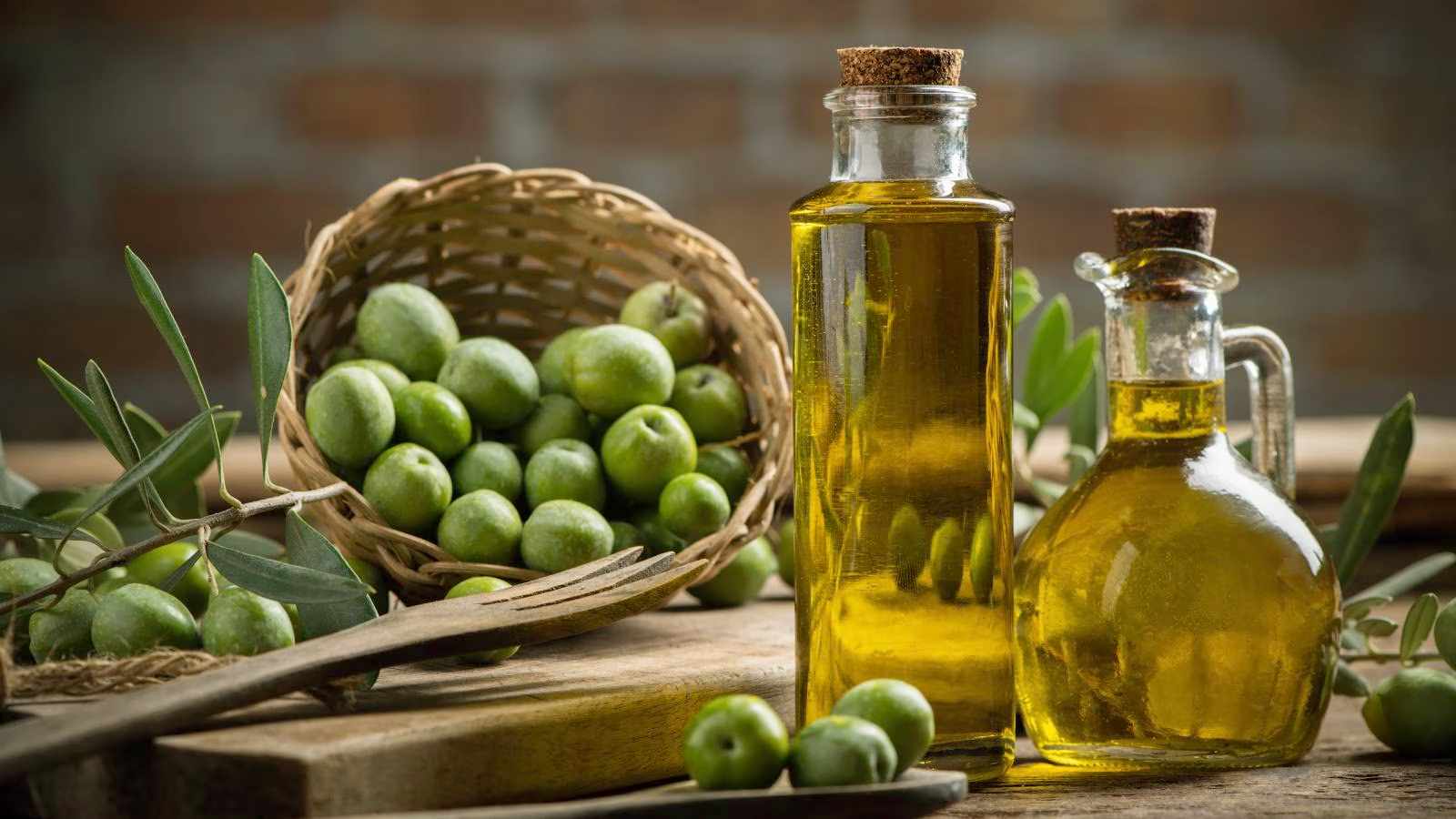















Pingback: Quick Ground chicken recipes healthy for Busy Weeknights